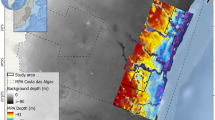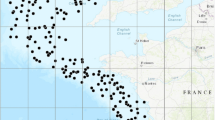Abstract
This study applies three classification methods exploiting the angular dependence of acoustic seafloor backscatter along with high resolution sub-bottom profiling for seafloor sediment characterization in the Eckernförde Bay, Baltic Sea Germany. This area is well suited for acoustic backscatter studies due to its shallowness, its smooth bathymetry and the presence of a wide range of sediment types. Backscatter data were acquired using a Seabeam1180 (180 kHz) multibeam echosounder and sub-bottom profiler data were recorded using a SES-2000 parametric sonar transmitting 6 and 12 kHz. The high density of seafloor soundings allowed extracting backscatter layers for five beam angles over a large part of the surveyed area. A Bayesian probability method was employed for sediment classification based on the backscatter variability at a single incidence angle, whereas Maximum Likelihood Classification (MLC) and Principal Components Analysis (PCA) were applied to the multi-angle layers. The Bayesian approach was used for identifying the optimum number of acoustic classes because cluster validation is carried out prior to class assignment and class outputs are ordinal categorical values. The method is based on the principle that backscatter values from a single incidence angle express a normal distribution for a particular sediment type. The resulting Bayesian classes were well correlated to median grain sizes and the percentage of coarse material. The MLC method uses angular response information from five layers of training areas extracted from the Bayesian classification map. The subsequent PCA analysis is based on the transformation of these five layers into two principal components that comprise most of the data variability. These principal components were clustered in five classes after running an external cluster validation test. In general both methods MLC and PCA, separated the various sediment types effectively, showing good agreement (kappa >0.7) with the Bayesian approach which also correlates well with ground truth data (r2 > 0.7). In addition, sub-bottom data were used in conjunction with the Bayesian classification results to characterize acoustic classes with respect to their geological and stratigraphic interpretation. The joined interpretation of seafloor and sub-seafloor data sets proved to be an efficient approach for a better understanding of seafloor backscatter patchiness and to discriminate acoustically similar classes in different geological/bathymetric settings.







Similar content being viewed by others
References
Alevizos E, Snellen M, Simons DG, Siemes K, Greinert J (2015) Acoustic discrimination of relatively homogeneous fine sediments using Bayesian classification on MBES data. Mar Geol 370:31–42. doi:10.1016/j.margeo.2015.10.007, ISSN 0025-3227
Amiri-Simkooei AR, Snellen M, Simons DG (2009) River bed sediment classification using MBES backscatter data. J Acoust Soc Am 126(4):1724–1738
Amiri-Simkooei AR, Snellen M, Simons DG (2011) Principal component analysis of single-beam echo-sounder signal features for seafloor classification. IEEE J Ocean Eng 36:259, 272. doi:10.1109/JOE.2011.2122630
Benediktsson JA, Sveinsson JR, Arnason K (1995) Classification and feature extraction of AVIRIS data. IEEE Trans Geosci Remote Sens 33(5):1194–1205
Bentley SJ, Nittrouer CA, Sommerfield CK (1996) Development of sedimentary strata in Eckernförde Bay, southwestern Baltic Sea. Geo-Mar Lett 16:148–154. doi:10.1007/BF01204502
Beyer A, Chakraborty B, Schenke HW (2007) Seafloor characterization of the mound and channel provinces of the Porcupine Seabight: an application of the multi-beam angular backscatter data. Int J Earth Sci. doi:10.1007/s00531-005-0022-1
Blondel P, Huvenne V, Huehnerbach V (2006) Multi-frequency acoustics of deep-water coral habitats and textural characterisation. In: Jesus SN, Rodriguez OC (eds.) Proceedings of the 8th European conference on underwater acoustics, 12–15 Jun 2006. 8th European conference on underwater acoustics carvoeiro, Portugal, ECUA Secretariat, pp 379–384
Brown CJ, Blondel P (2009) The application of underwater acoustics to seabed habitat mapping, Appl Acoust 70(10):1241. doi:10.1016/j.apacoust.2008.09.006, ISSN 0003-682X
Brown CJ, Smith SJ, Lawton P, Anderson JT (2011) Benthic habitat mapping: a review of progress towards improved understanding of the spatial ecology of the seafloor using acoustic techniques. Estuar Coast Shelf Sci 92:502–520. doi:10.1016/j.ecss.2011.02.007
Calinski T, Harabasz J (1974) A dendrite method for cluster analysis. Commun Stat 3:1–27
Calvert J, Strong JA, Service M, McGonigle C, Quinn R (2014) An evaluation of supervised and unsupervised classification techniques for marine benthic habitat mapping using multibeam echosounder data. ICES J Mar Sci. doi:10.1093/icesjms/fsu223
Che Hasan R, Ierodiaconou D, Laurenson L (2012a) Combining angular response classification and backscatter imagery segmentation for benthic biological habitat mapping. Estuar Coast Shelf Sci 97:1–9
Che Hasan R, Ierodiaconou D, Monk J (2012b) Evaluation off our supervised learning methods for benthic habitat mapping using backscatter from multi-beam sonar. Remote Sens 4:3427–3443
Che Hasan R, Ierodiaconou D, Laurenson L, Schimel A (2014) Integrating multibeam backscatter angular response, mosaic and bathymetry data for benthic habitat mapping. PLoS ONE 9(5):e97339. doi:10.1371/journal.pone.0097339
Collier JS, Brown CJ (2005) Correlation of sidescan backscatter with grain size distribution of surficial seabed sediments. Mar Geol 214(4):431–449. doi:10.1016/j.margeo.2004.11.011
Eleftherakis D, Snellen M, Amiri-Simkooei A, Simons DG, Siemes K (2014) Observations regarding coarse sediment classification based on multi-beam echo-sounder’s backscatter strength and depth residuals in Dutch rivers. J Acoust Soc Am 135(number 6):3305–3315
Erdey-Heydorn MD (2008) An ArcGIS seabed characterization toolbox developed for investigating benthic habitats. Mar Geodesy 31(4):318–358. doi:10.1080/01490410802466819
Fakiris E, Zoura D, Ferentinos G, Papatheodorou G (2014) Towards joint use of side scan sonar and subbottom profiler data for the automatic quantification of marine habitats. Case study: Lourdas gulf, Kefalonia isl., Greece, UA2014 2nd international conference and exhibition on underwater acoustics
Ferrini VL, Flood RD (2006) The effects of fine-scale surface roughness and grain size on 300 kHz multibeam backscatter intensity in sandy marine sedimentary environments. Mar Geol 228(1–4):153–172. doi:10.1016/j.margeo.2005.11.010
Folk RL (1954) The distinction between grain size and mineral composition in sedimentary-rock nomenclature. J Geol 62:344–359
Fonseca L, Mayer LA (2007) Remote estimation of surficial seafloor properties through the application angular range analysis to multibeam sonar data. Mar Geophys Res 28:119–126
Fonseca L, Brown C, Calder B, Mayer L, Rzhanov Y (2009) Angular range analysis of acoustic themes from Stanton Banks Ireland: a link between visual interpretation and multibeam echosounder angular signatures. Appl Acoust 70:1298–1304. doi:10.1016/j.apacoust.2008.09.008
Hamilton LJ, Parnum IM (2011) Acoustic seabed segmentation from direct statistical clustering of entire multibeam sonar backscatter curves. Cont Shelf Res 31:138–148
Hovland M, Judd AG (1988) Seabed pockmarks and seapages, impact on geology, and the marine environment. Graham and Trotman, London, p 293
Huang Z, Siwabessy J, Nichol S, Anderson T, Brooke B (2013) Predictive mapping of seabed cover types using angular response curves of multibeam backscatter data: testing different feature analysis techniques. Cont Shelf Res 61–62:12–22. doi:10.1016/j.csr.2013.04.024
Hughes Clarke JE (1994) Towards remote seafloor classification, using the angular response of acoustic backscatter: a case study from multiple overlapping GLORIA Data. IEEE J OceaN Eng 19:112–127
Ierodiaconou D, Burq S, Laurenson L, Reston M (2007) Marine habitat mapping using multibeam data, georeferenced video and image classification techniques: a case study in southwest Victoria. J Spatial Sci 52(1):93–104
Jensen JB, Kuijpers A, Bennike O, Laier T, Werner F (2002) New geological aspects for freshwater seepage and formation in Eckernförde Bay, western Baltic. Cont Shelf Res 22:2159–2173. doi:10.1016/S0278-4343(02)00076-6
Lamarche G, Lurton X, Verdier A-L, Augustin J-M (2011) Quantitative characterisation of seafloor substrate and bedforms using advanced processing of multibeam backscatter-application to Cook Strait, New Zealand. Cont Shelf Res, 31(2 suppl):S93–S109. doi:10.1016/j.csr.2010.06.001
Le Bas TP, Huvenne VAI (2009) Acquisition and processing of backscatter data for habitat mapping: comparison of multibeam and sidescan systems. Appl Acoust 70(10):1248–1257. doi:10.1016/j.apacoust.2008.07.010, ISSN 0003-682X
Lurton X, Lamarche G (eds) (2015) Backscatter measurements by seafloor-mapping sonars. Guidelines and Recommendations Geohab Report, p 200
McGonigle C, Collier JS (2014) Interlinking backscatter, grain size and benthic community structure. Estuar Coast Shelf Sci 147:123–136. doi:10.1016/j.ecss.2014.05.025
Müller H, von Dobeneck T, Nehmiz W, Hamer K (2011) Near-surface electromagnetic, rock magnetic, and geochemical fingerprinting of submarine freshwater seepage at Eckernförde Bay (SW Baltic Sea). Geo-Mar Lett 31(2):123–140. doi:10.1007/s00367-010-0220-0
Nittrouer CA, Lopez GR, Wright LD, Bentley SJ, D’Andrea AF, Friedrichs CT, Craig NI, Sommerfield CK (1998) Oceanographic processes and the preservation of sedimentary structure in Eckernförde Bay, Baltic Sea. Cont Shelf Res 18(14–15):1689–1714. doi:10.1016/S0278-4343(98)00054-5, ISSN 0278-4343
Parnum IM (2007) Benthic habitat mapping using multibeam sonar systems. PhD thesis, Curtin University, Perth, p 208
Preston J (2009) Automated acoustic seabed classification of multibeam images of Stanton Banks. Appl Acoust 70(10):1277–1287. doi:10.1016/j.apacoust.2008.07.011
Rzhanov Y, Fonseca L, Mayer L (2012) Construction of seafloor thematic maps from multibeam acoustic backscatter angular response data. Comput Geosci 41:181–187. doi:10.1016/j.cageo.2011.09.001
Siemes K, Snellen M, Amiri Simkooei A, Simons DG, Hermand JP (2010) Predicting spatial variability of sediment properties from hydrographic data for geoacoustic inversion. IEEE J Oceanic Eng 35(4):766–778
Simons DG, Snellen M (2009) A Bayesian technique to seafloor classification using multi-beam echo-sounder backscatter data. Appl Acoust 70:1258–1268. http://dx.doi.org/10.1016/j.apacoust.2008.07.013
Snellen M, Eleftherakis D, Amiri-Simkooei A, Koomans RL, Simons DG (2013) An inter-comparison of sediment classification methods based on multi-beam echo-sounder backscatter and sediment natural radioactivity data. J Acoust Soc Am 134(2):959–970. doi:10.1121/1.4812858
Sweeney EM, Gardner JV, Johnson JE, Mayer LA (2012) Geological interpretation of a low-backscatter anomaly found on the New Jersey continental margin. Mar Geol 326–328:46–54. doi:10.1016/j.margeo.2012.08.007, ISSN 0025-3227
Verfaillie E, Degraer S, Schelfaut K, Willems W, Van Lancker V (2009) A protocol for classifying ecologically relevant marine zones, a statistical approach. Estuar Coast Shelf Sci 83(2):175–185. doi:10.1016/j.ecss.2009.03.003, ISSN 0272-7714
von Deimling JS, Weinrebe W, Tóth ZS, Fossing H, Endler R, Rehder G, Spieß V (2013) A low frequency multibeam assessment: spatial mapping of shallow gas by enhanced penetration and angular response anomaly. Mar Petrol Geol 44:217–222. doi:10.1016/j.marpetgeo.2013.02.013, ISSN 0264-8172
Whiticar MJ (2002) Diagenetic relationships of methanogenesis, nutrients, acoustic turbidity, pockmarks and freshwater seepages in Eckernförde Bay. Mar Geol 182:29–53. doi:10.1016/S0025-3227(01)00227-4
Acknowledgements
We would like to specifically thank Sebastian Krastel (Institute of Geosciences, Christian-Albrechts-Universität, Kiel) and Christian Berndt (GEOMAR) for providing access to the MBES dataset collected in 2012. The SBP survey was supported by an Innomar Student Project which allowed us using the parametric SES-2000 sub-bottom profiler system with help by Peter Hümbs from Innomar. We would also like to thank, RV Littorina captain and crew, and Wärtsilä ELAC Nautik for providing a special pole for the SBP survey. Two anonymous reviewers are thanked as well as Dr. Geoffroy Lamarche for valuable comments and recommendations. We also thank Dr. Karin Meissner (Senckenberg) for providing the identification of macro-benthic organisms. Finally thanks go to Edna Hütten and Thomas J. Browning for providing valuable grammar and syntax corrections. This is publication 28 of the DeepSea Monitoring Group at GEOMAR.
Author information
Authors and Affiliations
Corresponding author
Appendix
Appendix
Rights and permissions
About this article
Cite this article
Alevizos, E., Snellen, M., Simons, D. et al. Multi-angle backscatter classification and sub-bottom profiling for improved seafloor characterization. Mar Geophys Res 39, 289–306 (2018). https://doi.org/10.1007/s11001-017-9325-4
Received:
Accepted:
Published:
Issue Date:
DOI: https://doi.org/10.1007/s11001-017-9325-4




